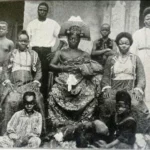Urithi wa Kutupwa Motoni
Katikati ya Jimbo la Edo la sasa, Nigeria, jumba la kifalme la Benin liliwahi kung'aa kwa usanii tofauti na Ulaya. Kuta, madhabahu na nyua zilimetameta kwa maelfu ya vibao vya shaba, michongo ya pembe za ndovu, na rekodi za maisha za chuma za kila kanuni ya nasaba, mpangilio wa ulimwengu, na kumbukumbu ya kitamaduni. Kwa pamoja, walijulikana kama Benin Bronzes.
Kazi hizi hazikuwa za mapambo tu bali taarifa za shaba kwamba wataalamu wa madini ya nta waliopotea wa Benin walijua mbinu za kushindana na Renaissance Ulaya, kurekodi Obas (wafalme), wapiganaji, matambiko, na kukutana na wafanyabiashara wa Ureno katika karne ya 15.
Janga la 1897
Mnamo Februari 1897, Uingereza ilizindua kile ilichokiita rasmi "Msafara wa Adhabu” Kufuatia mashambulizi ya kuvizia ya wajumbe wa Uingereza, maelfu ya wanajeshi walivamia, kuliteketeza jiji hilo, kuua watu wasiohesabika, na kupora hazina zake kwa utaratibu.
Wanajeshi wa Uingereza walivamia majumba, wakaharibu mahali patakatifu, na kupakiwa kwenye meli zilizokuwa zikielekea London. Katika suala la wiki, karne za usanii zilitawanyika kote ulimwenguni. Nyumba za minada, watozaji wa kibinafsi, na makumbusho kutoka Makumbusho ya Uingereza hadi Makumbusho ya Ethnological ya Berlin zikawa walinzi wapya wa urithi wa Benin. Kile ambacho kilikuwa kitakatifu na cha muktadha kilikuwa "udadisi" wa kigeni kwa maonyesho ya kifalme.
Sanaa kama Ushuhuda
Bronzes ni zaidi ya vitu. Kila bamba au kielelezo ni taarifa: kwamba wataalamu wa madini wa Benin waliamuru utupaji wa nta uliopotea katika ngazi ya kiufundi inayoshindana na Renaissance Ulaya, kwamba jamii yao ilirekodi historia katika shaba muda mrefu kabla ya kumbukumbu za ukoloni, na kwamba falme za Kiafrika.
haikuzalisha mali tu bali ustadi wa kiakili.
Ndio maana wizi wao ulipungua sana. Haikuwa mali tu iliyovuliwa, lakini kumbukumbu iliyovunjika katika mlolongo wa ufafanuzi wa kitamaduni.
Swali la Kurejesha Laibuka
Madai ya kurejeshwa nyumbani yalianza mapema kama miaka ya 1930, wakati machifu wa Edo walipowasihi wasimamizi wa kikoloni. Lakini mjadala huo ulipamba moto miaka ya 1960 baada ya uhuru wa Nigeria.
• Mifumo ya kisheria: Mkataba wa UNESCO wa 1970 kuhusu Mbinu za Kuzuia na Kuzuia Uagizaji Haramu, Usafirishaji nje, na Uhamisho wa Umiliki wa Mali ya Kitamaduni uliweka kielelezo cha kimataifa. Nigeria ilitia saini na kutunga Amri Na. 77 ya 1979, inayosisitiza umiliki wa serikali wa vitu vya kale.
• Mifumo ya kimaadili: Makavazi hayangeweza tena kuhalalisha kuonyesha kazi takatifu zilizochukuliwa
kwa nguvu. Wito wa kuondoa ukoloni ulifichua utupu wa “uporaji
kuwahifadhi” ulinzi.
EMOWAA: Kurudisha Nafasi, Kurudisha Hadithi
Uwanja ulivunjika mnamo 2021 kwenye Jumba la Makumbusho la Edo la Sanaa la Afrika Magharibi (EMOWAA) katika Jiji la Benin. Iliyoundwa na mbunifu David Adjaye, EMOWAA itafanya kazi kama mfumo wa kitamaduni, hifadhi ya sehemu, nafasi ya jamii, sehemu ya tovuti ya uponyaji. Kwa watu wa Edo, inaashiria kurudi kwa hadithi, heshima, na kumbukumbu kwenye udongo wao.
Kama fundi wa shaba Iyare Igbinovia anavyoonyesha,
"Ninapogusa udongo na kutupwa motoni, ninawafikiria akina mama waliowafundisha watoto wao wa kiume na wa kike kuchonga. Urejeshaji si tu kuhusu kurudisha shaba, ni kuhusu kufufua sauti yetu, ufundi wetu, na mustakabali wetu."
Changamoto za Urejeshaji
• Mahali: Je, Bronzes wanapaswa kuishi wapi? Matunzio ya EMOWAA yanatarajiwa kufunguliwa mwishoni mwa 2025, lakini mijadala ya kisiasa na ucheleweshaji wa ufadhili unaendelea.
• Uhifadhi dhidi ya Ukuu: Baadhi wanasema kuwa makumbusho ya Magharibi hutoa udhibiti bora wa hali ya hewa na usalama. Naijeria inapinga kwamba urithi wa kitamaduni unashinda vikwazo vya vifaa - na uwezo unakua.
• Wigo wa Kurudi: Je, urejeshaji unapaswa kuwa jumla au kwa awamu? Ni nani anayeamua ni vitu gani "viko tayari" kuacha makusanyo yaliyowekwa?
Hatua ya Kugeuka ya Ujerumani
Kwa miongo kadhaa, mazungumzo ya kurejesha pesa yaliyumba. Halafu, mnamo 2021, Ujerumani ilitangaza kuwa itarudisha zaidi ya shaba 1,000 kutoka kwa makusanyo ya serikali. Kufikia Julai 2022, makabidhiano rasmi ya kwanza yalifanyika Abuja.
Mchakato huo ulikamilika katika hafla ya 2024 Frankfurt ambapo viongozi wa Ujerumani walielezea kurudi kama sherehe "kitendo cha urafiki na haki." Rais wa Nigeria aliiita "kufunga kwa jeraha moja, na kufunguliwa kwa mustakabali wa uponyaji wa kitamaduni."
Hatua ya Ujerumani iliunda upya mjadala huo. Ikiwa uchumi mkubwa zaidi wa Uropa unaweza kurudi, kwa nini sio Uingereza?
Dilemma ya Makumbusho ya Uingereza
The Sheria ya Makumbusho ya Uingereza ya 1963 kisheria inazuia Makumbusho kutoka kwa vitu vya kudumu. Wadhamini wanasema mikono yao imefungwa. Bado wakosoaji wanaeleza kuwa sheria yenyewe inaakisi kujikita kwa ukoloni: iliyoundwa kuweka makusanyo yaliyoporwa daima.
Shinikizo limeongezeka. Maafisa wa Nigeria, viongozi wa Edo, na wanaharakati duniani kote wameitaka Uingereza kufuata mfano wa Ujerumani. Hata Bunge la Uingereza limekuwa na mijadala ya hivi majuzi kuhusu urejeshaji fedha, na kukiri kwamba msukosuko wa sasa unadhoofisha uaminifu wa maadili wa nchi.
Mifano Nyingine za Kurudi
Sio njia zote ni urejeshaji wa moja kwa moja. Baadhi ya taasisi huchunguza:
• Makubaliano ya pamoja ya uwakili - ambapo umiliki unarudi kwa Nigeria lakini mikopo inaruhusu kuonyeshwa nje ya nchi.
• Mikopo ya muda mrefu inayoweza kurejeshwa - ilikosolewa na wengine kama "hatua nusu."
• Urejeshaji wa kidijitali - Uchanganuzi wa 3D, maonyesho ya VR, na kumbukumbu za mtandaoni (Smithsonian ilizindua majaribio mnamo 2025). Ingawa ni muhimu kwa ufikivu, haya hayawezi kuchukua nafasi ya uzito wa kiroho na kitamaduni wa kurudi kimwili.
Sauti kutoka Benin
Katika Tamasha la kila mwaka la Igue, Oba Ewuare II anatoa wito wa "kuunganisha tena roho za mababu zetu na nyumba zao." Mafundi wenyeji wanaona kila kurudi kama uthibitisho wa ukoo ambao haujavunjika.
Waziri wa Habari na Utamaduni wa Nigeria athibitisha,
"Hii sio tu kuhusu vitu. Inahusu hadhi, utambulisho, na kurekebisha usawa wa kihistoria."
Rekodi ya Muda ya Upinzani na Urejeshaji
• Miaka ya 1930 - Machifu wa Edo watoa ombi kwa magavana wa kikoloni
• Miaka ya 1960 - Uhuru unaibua mjadala wa kitaifa
• 1970 - Mkataba wa UNESCO dhidi ya biashara haramu
• 2021 - Ujerumani inatangaza kurudi kwa shaba 1,000+
• 2022 - Makabidhiano ya kwanza huko Abuja
• 2024 - Ufaransa inarejesha mabaki; Sherehe ya Frankfurt
• 2025 - matunzio ya EMOWAA yanatarajiwa kufunguliwa
Mapambano ya Kimataifa
Bronze za Benin ni sehemu ya tapestry pana:
Kesi Asili Ya sasa Mahali Hali
Benin Bronzes Edo Kingdom, Nigeria Uingereza, Ujerumani, Marekani, Ufaransa, n.k. Marejesho ya kiasi (Ujerumani, Ufaransa, Smithsonian)
Marumaru ya Parthenon Ugiriki British Museum Mzozo unaoendelea na Uingereza
Asante Regalia Ghana, majumba ya makumbusho ya Ethiopia na familia ya kifalme Mikopo ya kiasi katika 2024
Maandishi Makdala, Ethiopia Uingereza na maktaba za Umoja wa Ulaya Baadhi zitarejea mwaka wa 2022
Jedwali linaonyesha jinsi shaba za Benin zilivyo mkuki wa mfano. Mafanikio hapa yanaweza kuwekwa
mfano kwa wengine.
Kwa Nini Ni Muhimu
Kwa msingi wake, urejeshaji sio juu ya nostalgia. Ni kuhusu siku zijazo. Kwa vijana wa Nigeria, kuona urithi wao nyumbani kunathibitisha kiburi na mwendelezo. Kwa ulimwengu, inatoa changamoto kwa makavazi kubadilika kutoka nyumba za nyara za kifalme hadi washirika wa kitamaduni wenye maadili.
Kama mwanahistoria mmoja wa kitamaduni wa Edo alivyosema:
"Shaba ni maktaba yetu. Huwezi kutuelewa bila hizo."
Hitimisho: Kutuma Mustakabali Mpya
Bronze za Benin zinajumuisha vurugu za uchimbaji wa kikoloni na uthabiti wa utambulisho wa kitamaduni. Safari yao kutoka kwa vihekalu vya kasri hadi vitrini vya vioo na sasa, kurudi kuelekea Jiji la Benin ni hadithi ya kupasuka na ukarabati.
Harakati za kurejesha pesa hazifuti yaliyopita. Inakubali, inakabiliana nayo, na inasisitiza kwamba ukarabati unawezekana. Katika mng'ao wa kung'aa wa shaba iliyotupwa, hatuoni tu historia, lakini uwezekano wa haki kufanywa dhahiri.
Ulimwengu unaweza kustaajabia shaba kama kazi bora, lakini kwa watengenezaji wao, ni jamaa. Hadi watakapopumzika kwa mara nyingine tena katika ardhi ya Benin, hadithi ya urejeshaji bado haijakamilika.
"Ikiwa urejeshaji utafaulu nchini Benin, unaweka kielelezo cha jinsi ulimwengu unavyoshughulikia wizi wa kitamaduni."
Machapisho yanayohusiana
-
Kifo na kuzaliwa upya kwa soka la Kenya: Fahari, sera, na ahadi ya enzi mpya
Jioni ya Nairobi yenye unyevunyevu, matatu hupiga honi katika msongamano wa magari huku wapiga debe wakizidi…
-
Jaribio la mapinduzi la Kenya la 1982: Matangazo, damu, na kuzaliwa kwa serikali ya polisi
Alfajiri ya Agosti 1, 1982, Wakenya waliamka kwa sauti ambayo haikuwa…
-
Ukweli Kuhusu Mauaji ya Benin
Kupitia eneo maarufu la King's Square linalojulikana kama barabara ya pete jijini...


